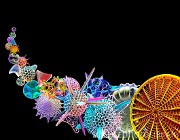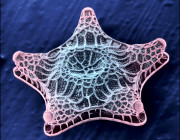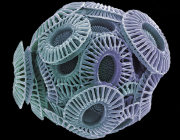Home :: List of Publicly Available Datasets :: Durinskia baltica CSIRO CS-38
Durinskia baltica CSIRO CS-38
Downloads:
| Principle Investigator(s) | Patrick Keeling |
|---|---|
| External sample ID | Durinskia baltica light (Db Light) |
| NCGR Sample ID | MMETSP0116_2 |
| Sample accession number | CAM_SMPL_002410 |
| Assembly accession number | CAM_ASM_000228 |
| Combined Assembly Name | Durinskia-baltica-CSIRO_CS-38 |
| Genus | Durinskia |
| Species | baltica |
| Strain | CSIRO CS-38 |
| Clonal | No |
| Axenic | No |
| Prelim. NCBI Taxon ID | 400756 |
| 18S rRNA | |
| Importance of organism and transcriptomes | Durinskia baltica is a marine dinoflagellate, which is closely related to the bloom-forming ubiquitous dinoflagellate Kryptoperidinium foliaceum. It belongs to a small group of dinoflagellates that are of particular interest to cell and evolutionary biology because they have lost photosynthesis in their ancestral plastid and replaced this activity with a diatom endosymbiont (a so-called tertiary plastid). The endosymbiosis is at a relatively early stage of integration, so the diatom retains a large nucleus and nuclear genome, many plastids, a large proportion of cytoplasm and, uniquely among all such symbioses, its own mitochondria. Altogether this means these single cells contain five or perhaps six genome containing compartments: two nuclei, two mitochondria, and one or two plastids (the fate of the original dinoflagellate plastid is as yet uncertain). The binucleate nature of these dinoflagellate/diatom consortia (called ?dinotoms?) also presents a unique opportunity to study the contribution of each nucleus to the control, function, and maintenance of the plastids (all of which are within the diatom endosymbiont), and mitochondria (which are found in the cytosol of both dinoflagellate and diatom), initially through identifying the nuclear-encoded transcripts for organelle-targeted proteins so as to assemble a complete list of organelle functions in the two eukaryotes. We propose two transcriptomic surveys (light conditions and dark conditions) from all three dinotoms that are available in public culture collections, to best identify the broadest possible range of genes in these complex biological systems. |
| Additional citations and references | |
| Environmental Data | |
| Primary citation for organism's characterization, if available | Kempton, J. W., Wolny, J., Tengs, T. et al. 2002. Kryptoperidinium foliaceum blooms in South Carolina: a multianalytical approach to identification. Harmful Algae 1: 383?92.; Tomas RN, Cox ER (1973) Observations on symbiosis of Peridinium Balticum and its intracellular alga.1. Ultrastructure. J Phycol 9: 304?323. ;Behzad Imanian., Jean-Francois Pombert., Patrick J. Keeling. 2010. The Complete Plastid Genomes of the Two `Dinotoms? Durinskia baltica and Kryptoperidinium foliaceum. PLoS ONE 5(5): e10711. doi:10.1371/journal.pone.0010711. |
| Collection date | 01-JAN-75 |
| Sample material (e.g. "seawater," "sediment," etc.) | Seawater |
| Volume filtered (L) | 2 |
| ENVO term for habitat - primary term | Acquatic: marine |
| ENVO term for habitat - secondary term | Other |
| Habitat | marine habitat |
| Country | UNITED STATES |
| Experimental Data | |
| Date of experiment | 28-FEB-11 |
| Growth medium | GSe amended sea water |
| Modifications to growth medium | 48 hours before harvest antibiotics were added to medium: 500 mg/L penicillin; 200 mg/L ampicillin; 100 mg/L streptomycin; 100 mg/L neomycin |
| Temperature (ºC) | 22 |
| Salinty (psu) | 18 |
| pH | 8 |
| Light (µmol photons / m2 / sec) | 550 |
| Day portion of day:night cycle in hours | 12 |
| Night portion of day:night cycle in hours | 12 |
| Nitrate (μmol/L) | 1000 |
| Phosphate (μmol/L) | 50 |
| Silicate (μmol/L) | 15 |
| Trace elements (total) (nmol/L) | 12000 |
| Investigation type | Eukaryotes |








